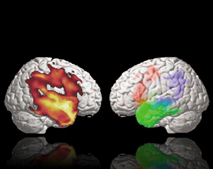Clinicopathologic correlations and neuroimaging biomarkers in primary progressive aphasia
The studies included in this thesis addressed the issue of clinicopathologic correlation in neurodegenerative disease and more specifically in primary progressive aphasia (PPA). In the first study we analyzed rates of amyloid PET positivity to test the hypothesis that classification according to the recently established consensus PPA variant diagnostic criteria would result in groups with largely homogeneous amyloid biomarker profiles. We found that the current classification scheme was highly predictive of amyloid biomarker status with logopenic variant (lvPPA) being associated to amyloid positivity in more than 95% of cases. Furthermore, the amyloid biomarker discordant cases (amyloid positive semantic variant [svPPA] and non-fluent/agrammatic variant [nfvPPA]) that had available autopsy data received a primary pathologic diagnosis of frontotemporal lobar degeneration (FTLD) with presence of contributing Alzheimer’s disease (AD) pathology, suggesting that cases of amyloid biomarker positive svPPA and nvfPPA might be more indicative of mixed FTLD – AD pathology than primary AD.
In the second study we identified clinical and neuroimaging features that may help predict underlying pathology in nfvPPA which is the most pathologically heterogeneous of the PPA clinical variants. Greater dysarthria and relative predominance of white-matter atrophy at presentation and greater rate of brainstem atrophy and appearance of brainstem clinical signs at follow-up were characteristic of underlying nfvPPA-progressive supranuclear palsy. NfvPPA-corticobasal degeneration showed more impairment in sentence comprehension, verbal working memory, and greater grey matter atrophy at presentation along with spread of atrophy to anterior cortical structures and greater presence of behavioral symptoms at follow-up.
The third study quantified and evaluated the ability of different cognitive and neuroimaging measures to predict which primary progressive aphasia patients have presumptive Alzheimer’s disease pathology (using amyloid-PET as a surrogate marker). A data-driven analysis was able to correctly classify 96% amyloid negative and 86% amyloid positive cases. We found that measures of visual memory and behavioral impairment show similar ability to predict amyloid-PET status as the best performing language measures, which were motor speech and sentence repetition suggesting non-language measures hold potential value for improving differential diagnosis.
Finally, the last study also investigated the relationship between amyloid deposition measured by PET-PiB imaging and brain atrophy. We found that, within lvPPA (which is generally due to AD), grey-matter volume loss was highly asymmetric and predominant in language regions whereas amyloid deposition was diffuse throughout association cortices and symmetric between hemispheres suggesting another factor different from amyloid deposition is driving progression of brain atrophy.

